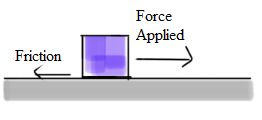
What is the direction of force of friction acting on a body moving on a fixed surface?
A. Along the direction of motion
B. Opposite to the direction of motion
C. It has no direction
D. At an angle to the direction of motion
Answer
498.9k+ views
Hint: Frictional force is an opposing force in general. Air resistance, friction when walking, etc. are some of the day-to-day examples of frictional force presence that we experience.
Complete step by step answer:

Frictional forces are responsible for exhausting us when we walk. If we are trying to slide a box like one shown in the diagram, we might experience friction opposing the force applied by us. It is just like a tug of war situation. We want to push the box forward but friction doesn't allow us. If we apply more force, then we might be able to push the box further. Thus, the resultant motion of the box is due to the force that is equal to the difference between the applied force and frictional force. What remains after subtracting the friction contribution is the force that is responsible to accelerate our object forward.
Now, if we increase the weight of the box, then we might experience further difficulty in pushing the box forward. If we make the surface below the box a little smoother, we might experience ease in pushing it forward. These two factors are something that determines the magnitude of the friction that the box will experience.
On a different note, consider a feather and a metallic ball freely falling. Ideally, both should reach the ground at the same time. We observe though that the feather takes more time to reach the ground than metallic balls. This is only due to the presence of air resistance.
The direction of frictional force is always opposite to the direction of motion. Friction always tends to oppose the applied force.
Therefore, the correct option is (B) Opposite to the direction of motion.
Note:
One might get confused here if the concept regarding the formula for friction is not very clear. The frictional coefficient multiplied by the normal component gives the magnitude of frictional force but clearly not the direction.
Complete step by step answer:

Frictional forces are responsible for exhausting us when we walk. If we are trying to slide a box like one shown in the diagram, we might experience friction opposing the force applied by us. It is just like a tug of war situation. We want to push the box forward but friction doesn't allow us. If we apply more force, then we might be able to push the box further. Thus, the resultant motion of the box is due to the force that is equal to the difference between the applied force and frictional force. What remains after subtracting the friction contribution is the force that is responsible to accelerate our object forward.
Now, if we increase the weight of the box, then we might experience further difficulty in pushing the box forward. If we make the surface below the box a little smoother, we might experience ease in pushing it forward. These two factors are something that determines the magnitude of the friction that the box will experience.
On a different note, consider a feather and a metallic ball freely falling. Ideally, both should reach the ground at the same time. We observe though that the feather takes more time to reach the ground than metallic balls. This is only due to the presence of air resistance.
The direction of frictional force is always opposite to the direction of motion. Friction always tends to oppose the applied force.
Therefore, the correct option is (B) Opposite to the direction of motion.
Note:
One might get confused here if the concept regarding the formula for friction is not very clear. The frictional coefficient multiplied by the normal component gives the magnitude of frictional force but clearly not the direction.
Recently Updated Pages
Master Class 11 Economics: Engaging Questions & Answers for Success

Master Class 11 Business Studies: Engaging Questions & Answers for Success

Master Class 11 Accountancy: Engaging Questions & Answers for Success

Master Class 11 English: Engaging Questions & Answers for Success

Master Class 11 Computer Science: Engaging Questions & Answers for Success

Master Class 11 Maths: Engaging Questions & Answers for Success

Trending doubts
State and prove Bernoullis theorem class 11 physics CBSE

What are Quantum numbers Explain the quantum number class 11 chemistry CBSE

Write the differences between monocot plants and dicot class 11 biology CBSE

Why is steel more elastic than rubber class 11 physics CBSE

Explain why a There is no atmosphere on the moon b class 11 physics CBSE

1 ton equals to A 100 kg B 1000 kg C 10 kg D 10000 class 11 physics CBSE




